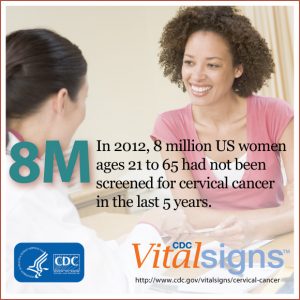Human papillomavirus (HPV) is by far the most prevalent sexually transmitted infection (STI) reported, new or new and existing combined, HPV accounts for approximately 79 million of the total STIs in the United States.

The CDC says most sexually active men and women will get HPV at some point in their lives, which translates to everyone’s at risk.
Although the body’s immune system clears most HPV naturally within two years (about 90 percent), some infections can persist causing diseases like genital warts and more seriously, cervical and other cancers.
In a recent Centers for Disease Control and Prevention (CDC) telebriefing, CDC Principal Deputy Director, Ileana Arias, PhD said cervical cancer is a top cancer cause for women, currently ranking number 13 for new cancer cases and number 14 for cancer deaths.
“We have seen incredible reductions in cervical cancer incidents and deaths since the Pap test was introduced in 1950 for cancer screening. We know that cervical cancer screening works”, Dr. Arias said. “Today, we have additional screening and prevention tools, including testing for the human papillomavirus or HPV, which could lead to cervical cancer and the HPV vaccine, which could prevent getting an HPV infection. Together cervical cancer screening and HPV vaccine could prevent as many as 93 percent of all cervical cancers.”
However, despite the availability of such effective screening, every year, 12,000 women get cervical cancer and 4,000 women still die from it. While deaths from cervical cancer has fallen since the 1950s, the US has stagnated in recent years between 2007 and 2011 where the death rate remained stable.
What’s going wrong?
According to Arias, in 2012 over eight million women between the ages of 21 and 65 didn’t get this life-saving screening in the past five years.
While the lack of health insurance and a doctor has contributed to these numbers, more significantly, of the women not screened, seven in ten women did actually have a regular doctor and health insurance.
The HPV vaccine is a key component of preventing cervical and other cancers. However, Dr. Arias points out despite knowing the effectiveness of the HPV vaccine in protecting against HPV infections that cause most cervical cancers, we know that right now only about one out of every three girls and one out of every seven boys have received all three doses of the vaccine for protection.
Preteens and teens are not getting HPV vaccination as often as other recommended vaccines, even though it is safe and it is effective. These numbers show us that we continue to miss opportunities to prevent cervical cancer.
“We already know that over half of cervical cancers occur in women who have never been screened or who have not been screened in the past five years. Increasing screening among these women will make the greatest impact on the cervical cancer burden in the U.S. Every visit to a provider is an opportunity to screen or make sure that women are getting screened, and that preteens and teens are getting vaccinated”, Arias closed.
For more infectious disease news and information, visit and “like” the Infectious Disease News Facebook page


One thought on “Cervical cancer screening and HPV vaccine could prevent as many as 93 percent of all cervical cancers: CDC”